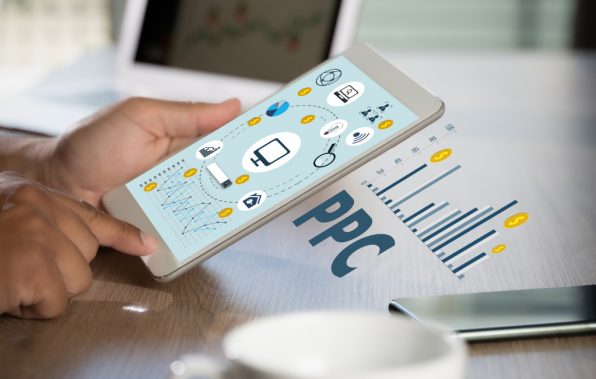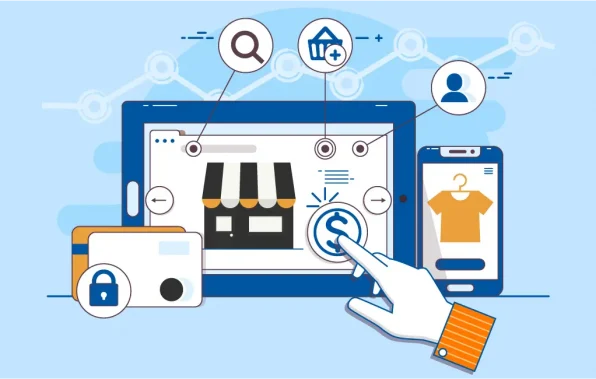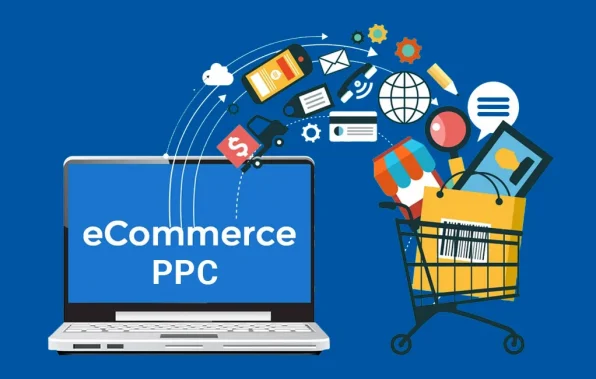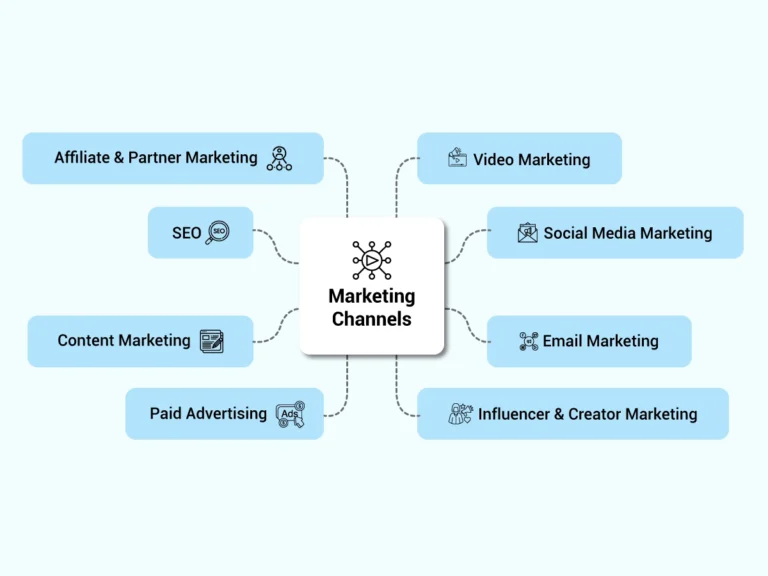Are you having a tough time with your Ecommerce PPC management? And thus wondering if there is an easier way to navigate the complexities without losing your sanity?
Well, this blog is here to the help.
From choosing the right platforms and keywords to optimizing your ad copy, we have got you covered. So you can find the perfect balance between budget and results.
Spoiler alert: There isn’t one, but we have got the next best thing that will not let your ecommerce PPC campaigns only thrive but also be a lot more easier.
But before we delve into the nitty-gritty details, let’s tackle the basics and redefine your approach to PPC. So, you can understand things better.

So, What is Ecommerce PPC Management?
Ecommerce PPC Management is all about strategically placing ads on search engines and websites, and you only pay when someone actually clicks on your ad.
No clicks, no cost – it’s like the fairytale version of advertising where you only pay for results.
Now, let’s break it down a bit. When someone types a search query into Google or another search engine, PPC ads are the sponsored listings that pop up at the top or bottom of the search results. That is, Ecommerce businesses bid on specific keywords relevant to their products. So, when a user types in one of those keywords, a lightning-fast auction takes place, and the highest bidder’s ad gets displayed.
But it’s not just about throwing money at the highest bid. Effective E-commerce PPC Management involves crafting compelling ad copy, selecting the right keywords, and targeting the ideal audience. It’s a bit like matchmaking – connecting your products with people who are actively searching for what you offer.
For instance, you sell eco-friendly yoga mats. Thanks to PPC Management, when someone googles “sustainable yoga mats,” your ad might appear, shining like a beacon of environmentally friendly fitness goodness. The potential customer clicks your ad, lands on your site, and voila – a match made in advertising heaven.
However, the magic doesn’t stop there. This E-commerce PPC Management also provides detailed insights into how well your ads are performing. You can track clicks, conversions, and other metrics, giving you the power to adjust your strategy on the fly. Much like having a crystal ball for your marketing efforts.
What is Ecommerce Advertising?
Ecommerce advertising is the digital marketing strategy of promoting online stores and their products through paid online channels like social media, display ads, and search engines.
In other words, Ecommerce advertising is like having your own personal PR team dedicated to putting your products in the spotlight. It’s about creating buzz, turning heads, and convincing shoppers that your online store is the place to be for all their wants and needs.
For example, you have an online store selling handmade jewelry. Ecommerce advertising would involve creating captivating ads showcasing your unique pieces and strategically placing them on platforms like Instagram or Google, targeting users interested in jewelry.
But wait, there’s more! Ecommerce advertising isn’t just about plastering your products everywhere; it’s about targeting the right audience, based on demographics, interests, online behavior and so on.

What is PPC for Ecommerce?
PPC for Ecommerce, or Pay-Per-Click advertising, is a targeted strategy where online businesses pay for their ads to appear prominently in search engine results. Advertisers only pay when users click on their ads, driving potential customers directly to their online stores.
In simple terms, PPC for Ecommerce is like turning on the turbo boost for your online visibility. It’s a strategic advertising game where you only pay when someone clicks on your ad.
For instance, you sell handmade candles. With PPC for Ecommerce, when someone searches for “artisan candles,” your ad could pop up at the top of the search results. If the user clicks on your ad, they land directly on your online store, ready to explore and make a purchase. Ultimately becoming your newest fan.
But wait, there’s more! PPC for Ecommerce isn’t a one-size-fits-all affair. It’s about targeting the right audience – those who are actively searching for what you offer. If you sell gourmet chocolates, your PPC ads might pop up when someone types in “decadent chocolate treats.” It’s all about connecting with chocolate enthusiasts at the perfect moment.
What is PPC Advertising?
PPC Advertising, or Pay-Per-Click advertising, is a digital marketing strategy where advertisers pay a fee each time their ad is clicked. It’s a way to attract targeted audiences and drive traffic to websites.
In simple terms, PPC Advertising is like a win-win game. You create ads, and you only shell out some digital dollars when someone clicks on your ad.
For instance, you are selling handcrafted jewelry. With PPC Advertising, when someone searches for “unique handmade necklaces,” your ad could appear at the top of the search results. You only pay when someone clicks on your ad and visits your online store.
But hold on, there’s more dazzle to this digital dance. PPC Advertising is a strategic waltz with keywords. You bid on specific words related to your product or service, ensuring your ad shows up when someone searches for those keywords. Much like whispering in the ear of the internet, making sure your message is heard by the right audience.

How to Start and Manage an Ecommerce PPC Campaign?
Ecommerce PPC (Pay-Per-Click) can be both thrilling and rewarding. After all, it’s like sending out digital ambassadors to bring potential customers straight to your virtual doorstep.
Didn’t understand?
Here’s how to start and manage an Ecommerce PPC campaign that not only grabs attention but also converts browsers into buyers:
Step 1: Set Clear Goals and Aim High
Well, think big! Establish crystal-clear goals that will guide your campaign. Whether it’s skyrocketing sales, building brand awareness, or directing traffic to a particular product, having a solid goal is like having a rocket booster for your Ecommerce ambitions.
Step 2: Get to Know Your Audience Like Best Friends
Next up, try to think of your target audience as your best buddies. Understand their likes, dislikes, online habits, and preferences. So you can craft your ads to speak directly to them, creating a connection that’s irresistible.
Step 3: Choose the Perfect Platform, Your Digital Stage
Selecting the right PPC platform is like picking the perfect stage for your performance. Google Ads and Facebook Ads are often the go-to-choice – often stealing the spotlight. Google for those high-intent searches, and Facebook for its dazzling audience targeting capabilities.
Step 4: Craft Compelling Ad Copy
Your ad copy is the virtual salesperson enticing customers to click. Hence, make it compelling, concise, and straight to the point. Highlight your products unique selling points – be it promotions, features or anything that captivates and sets your products apart.
Step 5: Set a Budget and Bid Like a Pro
Allocate your budget wisely and choose a bidding strategy that aligns with your goals. Whether it’s cost-per-click (CPC), cost-per-acquisition (CPA), or return on ad spend (ROAS) – make sure to pick the strategy that ideally suits your business objectives.
Step 6: Utilize the Power of Ad Extensions
Simply state, ad extensions are like the bonus features for your ad.
To be more precise, they provide extra information, like links to specific product pages, location information, or additional snippets that make your ad an absolute must-watch. Therefore, try to make the most use of it to give potential customers more reasons to click.
Step 7: Monitor and Optimize Regularly
Your PPC campaign is not a ‘set it and forget it’ affair. Hence, regularly monitor performance metrics, tweak ad copies, adjust bids, and test different elements to find the winning formula. That is, be the ultimate master, adapting the composition for a standing ovation.
Step 8: Remarketing - Bring Back the Lost Souls
Don’t let potential customers slip through the cracks. Set up remarketing campaigns to re-engage with users who visited your site but didn’t make a purchase. Much like giving them a friendly nudge to come back and complete the transaction. Often does wonders!
Step 9: Analyze Data and Become the PPC Scientist
Data is your best friend in the digital marketing world. So, make sure to take a deep dive into the data ocean and analyze, analyze, analyze!
Track conversions, understand user behavior, and transform into a PPC scientist. That is, use insights to refine your strategy, focusing on what works and tweaking what doesn’t.
Step 10: Stay Ahead of Trends - The Trendsetter's Anthem
E Commerce is a fast-paced game, where trends rule. And your job is to stay updated on latest industry trends, new features on PPC platforms, and emerging technologies. Being ahead of the curve makes sure your campaigns remain fresh and effective – grabbing the limelight.

Why Use PPC for Ecommerce Stores?
Using PPC (Pay-Per-Click) for eCommerce stores is like giving your online business a turbo boost. Let’s break it down for you in a way that will make you want to grab your digital marketing cape and take flight:
Instant Visibility Boost
PPC is kind of a magic spell that propels your store to the top of search engine results. When someone types in a relevant keyword, bam!
There you are, right at the top, waving hello to potential customers.Much like having a prime spot in a bustling marketplace without having to elbow your way through the crowd.
Targeted Reach
PPC platforms allow you to get laser-focused on your audience. Whether it’s demographics, interests, or even device preferences, you can tailor your ads to reach the people most likely to be interested in your products.
Control Over Budget and Spending
With PPC, you are the captain of your financial ship. You can easily set a budget that suits your business, and only pay when someone clicks on your ad.
It’s cost-effective and ensures you are not burning money on irrelevant views; rather you are only investing in actual engagement where every penny is a potential customer.
Enhanced Brand Awareness
With PPC, your brand becomes a familiar face in the online crowd. In fact, even if users don’t click on your ad immediately, the exposure contributes to long-term brand awareness. Much like planting seeds that will blossom into customer recognition.
Data-driven Superpowers
PPC platforms are not just about throwing ads into the digital void and hoping for the best. Yes, you heard it, right.
That is, you get detailed insights into how your ads are performing. You can track clicks, conversions, and see which keywords are performing in real-time. Much like having a dashboard that shows you exactly how well your Ecommerce store is doing at any given moment.
Flexibility and Adaptability
In the dynamic world of Ecommerce, things change at the speed of a click. PPC campaigns allow you to adapt swiftly. Need to highlight a flash sale, a new product, or respond to a sudden trend? With PPC, you can tweak your ads on the fly, staying agile in the digital world.

Wrapping Up
There you have it – a roadmap to hassle-free Ecommerce PPC management that’s as effective as it is easy. The journey might seem daunting, but armed with the right knowledge, it becomes a thrilling adventure.
Luckily, armed with insights from our expert guide, you are now fully equipped to tackle the dynamic world of online advertising with total confidence. Remember, success is just a well-optimized PPC campaign away and at the end of the day, it’s not just about managing campaigns; it’s about mastering them as well.
So, what are you waiting for?
Go ahead, implement these strategies, and watch your Ecommerce venture soar to newer heights of success. Happy Campaigning!
FAQs
PPC, or Pay-Per-Click, in Ecommerce is a digital advertising model where businesses pay a fee each time their ad is clicked. It’s the art of driving targeted traffic to your site and boosting sales, where you pay only when someone clicks on your ad. In simpler terms, it’s turbocharging your visibility in the digital marketplace.
It involves strategizing, optimizing, and overseeing your Pay-Per-Click campaigns. From keyword research to budget control, it ensures your ads hit the right notes, maximizing your ROI and elevating your brand.
Nail the essentials with these five key aspects: keywords that resonate, compelling ad copy, finely-tuned landing pages, budget mastery, and constant analysis. After all, it’s not just about clicks; it’s about crafting a smoother and effective user journey that turns clicks into conversions!









